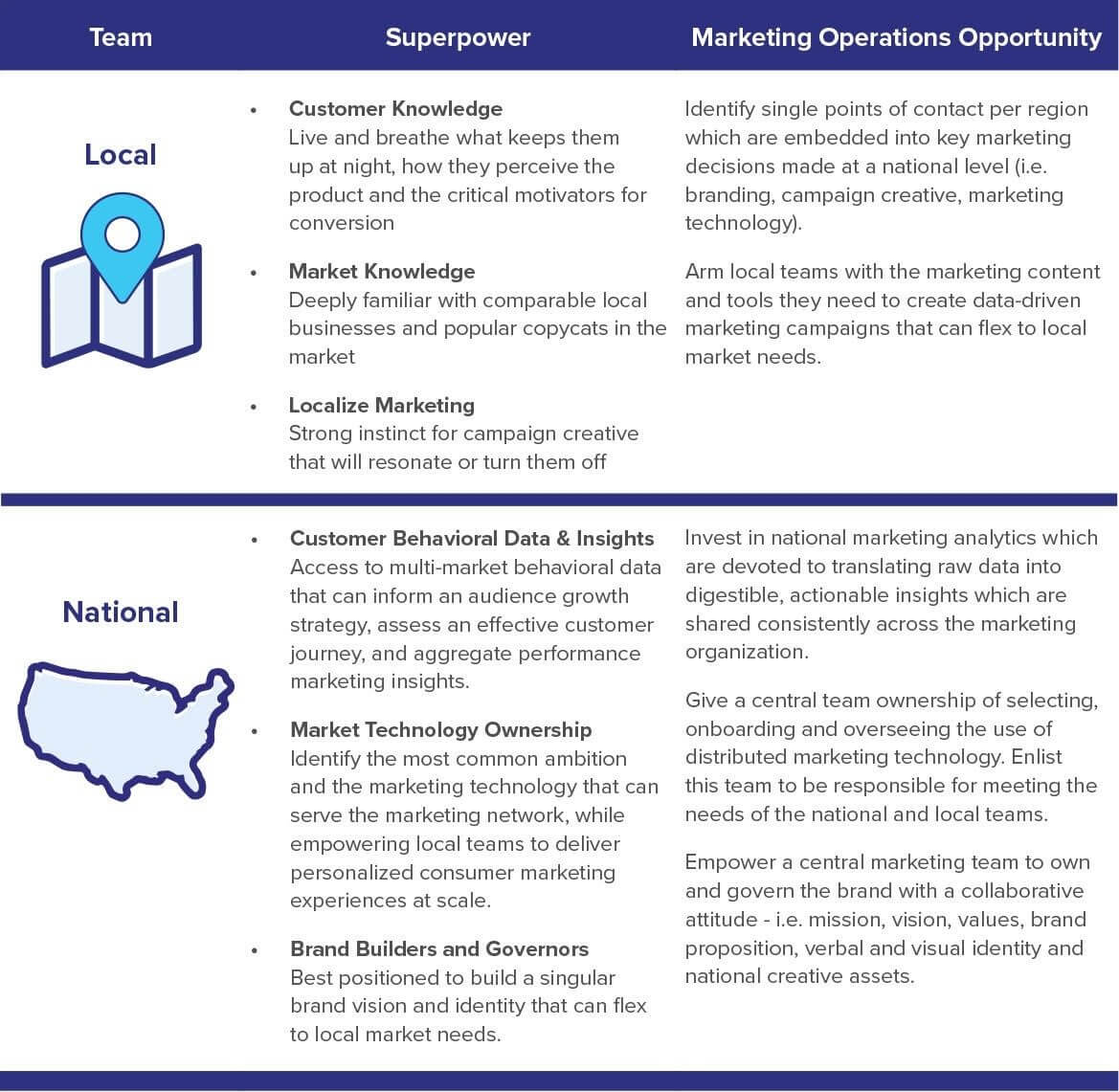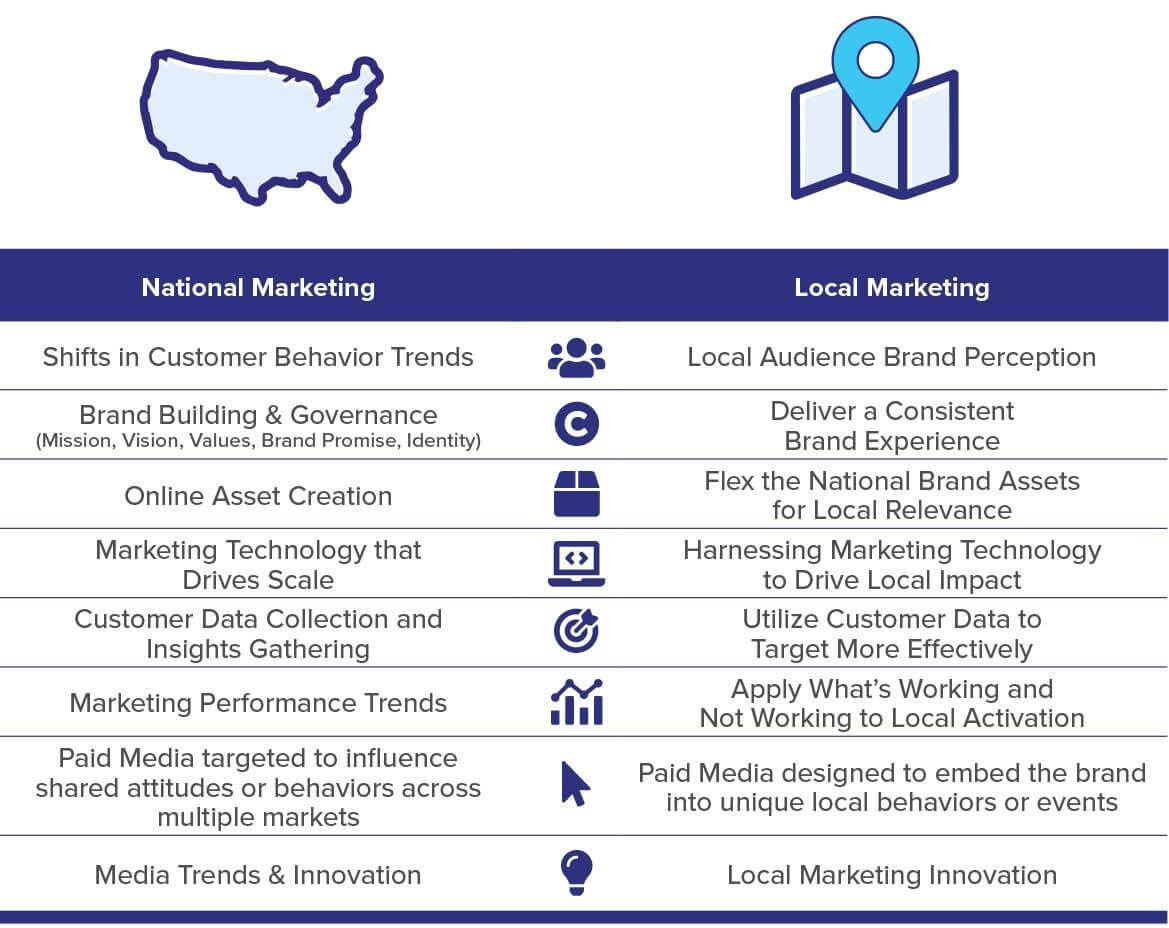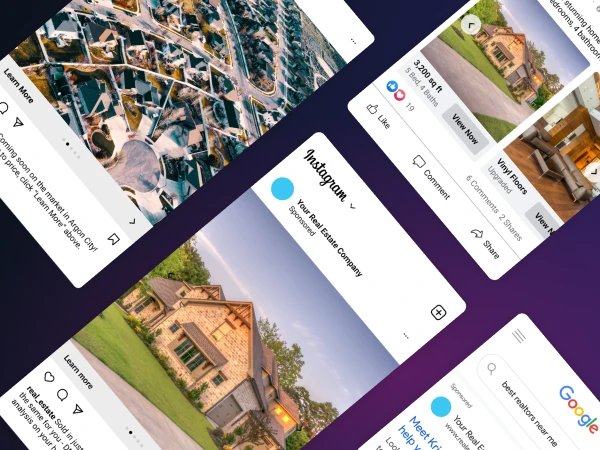
National-to-local marketing: How can the implementation of an operating model make or break your distributed marketing strategy?
Share
Schedule a 30-min marketing strategy call with our team
Brands that win strategically harness the power of their collective marketing network to generate new revenue while reducing operating costs. Here’s how marketing leaders build the operating model to make that happen.
The acceleration in marketing technology and data management is fueling an electric excitement among marketers who are passionate about delivering exceptional consumer marketing experiences that drive business growth. It offers a promise of better consumer experiences, greater return on investment and more confidence that what we invest will translate to the outcomes we want. This future state of marketing that we’ve been dreaming of is finally within reach.
The two critical steps in shaping these impactful consumer experiences are building an effective internal operating model and empowering teams with distributed marketing technology. However, businesses ranging from large corporations to startups often suffer from the age-old challenge of executing a strategic vision through a national-to-local coordinated effort. Too often, marketing teams fail to design a well coordinated strategic model that includes shared goals, clear roles and responsibilities and the sharing of valuable digital audiences, creative, and best practices.
As a result, these fragmented consumer experiences cause consumer confusion rather than inspiration and can erode trust with potential high value customers. Winning these customers back costs more than the investment required up front to map a well-designed operating model and distributed marketing strategy.
Building a successful digitally-driven national-to-local marketing operating model is often bumpy, repeatedly challenges teams to creatively problem solve and requires a strong commitment from the leadership team. But it is achievable if you start with these five core requirements:
1. Unify Teams Around Shared Goals
Start by rallying your marketing workforce around a shared purpose and define success criteria. What is the biggest possible impact your collective marketing organization can have in the world? How can digital marketing generate new revenue for the business? How will you know when you’ve succeeded? How can you leverage distributed marketing technology to help you get there?
Employees are motivated by the opportunity to be a part of something greater than themselves. Marketing leaders that shape a purpose and communicate it clearly and consistently inspire employee motivation. Productivity, creativity and collaboration accelerate when employees believe in the unifying purpose and each employee is clear how they contribute to the outcome.
2. Demonstrate Commitment
Keep teams motivated by demonstrating an ongoing commitment to the shared goals. An internal movement ignites with an inspirational speech, but leaders’ investment of time and resources play a critical role in employee engagement and productivity. This investment signals to employees that leadership can be trusted to set them up for success.
A few examples of how leaders can build employee trust and maintain productivity are:
- Appointing a single team leader, or program manager, who is tasked to help everyone work towards the shared goals
- Actively soliciting input from your national and local team members
- Removing projects that are not mission critical or contribute to the shared goal
- Providing required resources, tools and budget to meet expectations
- If new to distributed marketing technology, spending the time to learn what role it can play in generating revenue and reducing operational costs for the business
3. Activate Your Teams’ Superpowers
Assign clear boundaries and responsibilities across the national and local marketing teams by carefully considering each team’s superpowers. Which teams are closest to the customer? Which teams are best suited to manage marketing technology? Who should own the brand identity? By leaning into a team’s superpowers, leaders can improve the efficiency and effectiveness of their marketing.
The most common superpowers among local and national teams are:

The challenge is businesses are often moving so fast they miss the opportunity to orchestrate the mastery of a great operating model. However, taking the time to empower teams and individuals with ownable goals that are communicated transparently across a marketing network stops organizational chaos, reduces internal friction and prevents investing in marketing that does not drive results.
Role definition must be customized to each business, but the following table reflects common boundaries between national and local marketing teams that translate to a well coordinated digital marketing performance engine.
National versus Local Marketing Role Definition

4. Maximize Distributed Marketing Technology
CMOs who oversee marketing teams spread across markets with 50+ end users need distributed marketing technology to maintain brand consistency while empowering teams to flex digital advertising campaigns for local market relevance. The right distributed marketing technology combined with a powerful data architecture, can enable national and local teams to engage consumers effectively and deploy targeted Facebook and Google campaigns with a few clicks of a button. It can empower local marketers to humanize the consumer marketing experience using automation, while saving them time and money.
However, without a national investment, local marketers often invest in tactics based on instinct and rely on the same 2nd party audience targeting as their competitors. Local marketers do not commonly have access to these tools due to the cost of entry and the time required to manage the complexity in data management. Brands win when a national marketing team invests in the technology and continuously updates local marketers with distributed marketing technology best practices, audiences insights and impactful creative. In addition to improving local marketing effectiveness, an investment in technology will be maximized if the technology and data is leveraged at scale though local marketers.
In fact, the national team should have some level of accountability for driving local market usage and satisfaction. They can achieve this by serving as the single point of contact for distributed marketing technology education, fielding questions, troubleshooting and ensuring the MarTech continues to evolve as local market needs and aspirations change.
5. Build an Internal Communications Pipeline
Distributed Marketing networks with thoughtful, effective internal communication strategies improve performance more than businesses with poor communication. A good communications pipeline draws upon the following elements working together to drive the desired impact:
- Reinforce the Shared Purpose – Leadership needs to remind employees of the company’s commitment to the shared goals and the critical steps needed to succeed.
- Foster Sharing – Prioritize knowledge sharing across national and local teams. This could include an investment in a platform or dedicated internal resources.
- Enlist Local Marketing Representatives – Create a council of single points of contact across the local marketing teams with whom the national team meets with on a regular basis to discuss topics such as new creative, consumer insights and new digital advertising opportunities.
- Solicit Feedback from Employees – Give employees a safe space to communicate their concerns and questions. Otherwise, you risk not realizing you have a problem to solve.
How and what channels you use to build an effective communications pipeline should be driven by the company culture and values. It may require some trial and error, but the key is to keep listening, optimizing and learning.
Considerations
The path for businesses to capitalize in this future state of marketing is equal parts exhilarating and challenging. The promise of new possibilities for greater impact sparks creativity and productivity. At the same time, marketers willing to take this big giant step forward must be prepared to face hurdles without giving up. It requires strategic thinking to often override reactionary decision making, internal collaboration over fragmentation, and tenacity to be louder than fear.
As someone who has been on the front lines of advocating for digital marketing, marketing technology and a unified view of the customer through data, I can tell you that it is worth it for the right businesses. The gratification that comes when the pieces of the puzzle come together and translate to measurable growth at scale is powerful. It is at this point, that marketers are no longer focused on creating the fuel, but tuning an engine to move faster.
Share
Subscribe to our blog
Don’t miss a beat in the fast-changing local digital marketing landscape — sign up to stay ahead of the curve!






